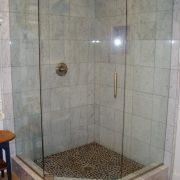Designing Showers for Disabled Individuals
Showers can present obstacles for individuals with disabilities. A shower for disabled should contain adaptations for users in wheelchairs so they can use it independently. These adaptations do not involve major changes to the traditional shower design. The considerations for an accessible design should include space, height and access to devices such as seats and safety bars.
Instructions
- Measure the space available for the shower. Use a real wheelchair to determine whether there is sufficient space to maneuver in and out, transfer to a shower seat and remove the wheelchair.
- Make sure the shower floor is flat with extensive drains so that it is not slippery. Use of a regular shower is not possible because the walls would block the entrance of the chair. Accessible showers incorporate a small ridge in the design that borders the entrance to the shower and holds the water in the area.
- Create privacy for the user of the wheelchair in the shower. Install a curtain, a sliding door or a door that opens outward, leaving ample room for a chair to pass through it.
- Put the operating controls of the shower and its components within the reach of the user. This includes the shower head, faucets, soap tray and temperature controls. The user should be able to reach without stretching when seated. For disabled users, you can install a separate support so that they can move the shower head and shower hands free.
- Install a shower seat at a height that makes for easy transfer to and from the wheelchair. A folding seat is a good idea when space is limited.
- Install grab bars at a height where they can easily be grasped by the user for support in case of a fall. The bars should be well positioned to help the user of the wheelchair to help with transferring to and from the shower seat.
Tips & Warnings
- Allow additional space in the shower to maneuver the wheelchair so walls and shower fixtures won’t accidentally get damaged.
- If the shower is located in a bathroom, it is better to have gates that can open out, allowing the individual in the wheelchair to close it behind him.






